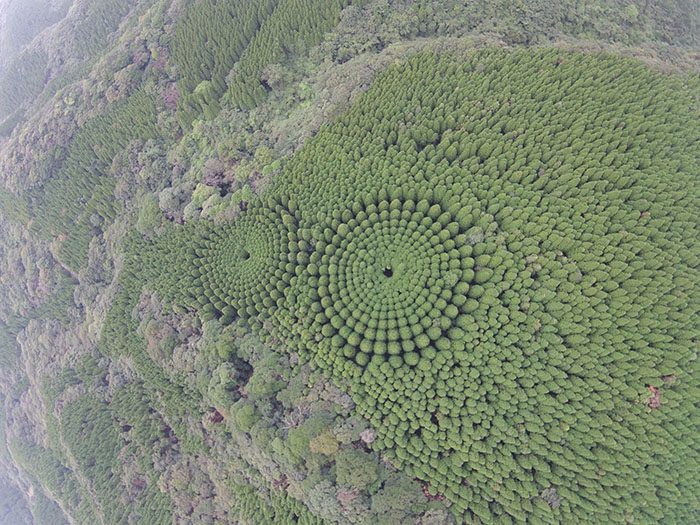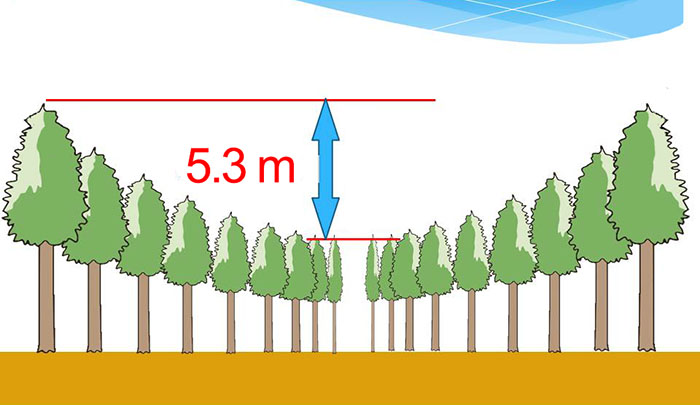
Japanese Experiment That Took Half A Century Ended In Amazing Tree ‘Crop Circles’
Crop circles are a staple of the conspiracy theory crowd, with the artistic creations in cereal fields often attributed to UFO landings, or intricate forms of Alien communication. So imagine the excitement some must’ve felt when photos of incredible geometric designs emerged in a forest in Japan recently, not from some squashed wheat, but from large, mature Japanese cedar trees.
What kind of extra-terrestrial sorcery is this? Sadly, for those who want to believe, there is a perfectly innocent, yet still interesting explanation that originates firmly here on planet Earth.
Back in 1973 scientists began a project in ‘experimental forestry,’ with the aim of learning about the spacing of trees and its effect on growth. They planted circles of cedars near Nichinan City in Miyazaki Prefecture, with smaller inner circles expanding incrementally into larger radiuses to create 10 perfect rings.
As you can see in the photo below, the experiment seems to show clear results. The concave shape suggests that the outer circles of least density promote a higher growth, with the tree size getting steadily smaller as the density increases.
Makes sense right? More space equals less competition for resources such as water and sunlight, so it’s easier for these outer trees to grow bigger and stronger while those on the inside fight it out amongst themselves.
According to a document from Japan’s Ministry of Agriculture, Forestry and Fisheries, the eventual height difference between the smallest trees at the center and the tallest trees on the outer ring was over 5 meters.
The trees are due to be harvested soon, with the experiment drawing to a close. But such is the interest in this unexpectedly beautiful result there remains the possibility that these giant ‘crop circles’ could be preserved, and perhaps even become a tourist attraction in the future!
h/t: Colossal
Here’s what people had to say about the cool experiment
127Kviews
Share on FacebookYou are welcome: https://www.google.com/maps/place/31%C2%B043'50.3%22N+131%C2%B023'04.9%22E/@31.7305041,131.3844973,229m/data=!3m1!1e3!4m5!3m4!1s0x0:0x0!8m2!3d31.730638!4d131.384693?hl=en-JP
I think that I shall never see A poem lovely as a tree. A tree whose hungry mouth is prest Against the earth’s sweet flowing breast; A tree that looks at God all day, And lifts her leafy arms to pray; A tree that may in Summer wear A nest of robins in her hair; Upon whose bosom snow has lain; Who intimately lives with rain. Poems are made by fools like me, But only God can make a tree.....joyce kilmer
The study of growth rate is fascinating, but I am curious to see a study of the lumber from these trees. The fastest growth may not result in the highest lumber quality. I would surmise that the best quality wood might come from trees somewhere in the middle, rather than the most cramped, or most spread-out trees. I have worked with plantation-grown pine from New Zealand, and the growth-rings are ENORMOUS, over 1/2" sometimes. The lumber is straight and clear, but more flexible than is useful for furniture or for construction. The same may be true of the outer ring of these trees.
You are welcome: https://www.google.com/maps/place/31%C2%B043'50.3%22N+131%C2%B023'04.9%22E/@31.7305041,131.3844973,229m/data=!3m1!1e3!4m5!3m4!1s0x0:0x0!8m2!3d31.730638!4d131.384693?hl=en-JP
I think that I shall never see A poem lovely as a tree. A tree whose hungry mouth is prest Against the earth’s sweet flowing breast; A tree that looks at God all day, And lifts her leafy arms to pray; A tree that may in Summer wear A nest of robins in her hair; Upon whose bosom snow has lain; Who intimately lives with rain. Poems are made by fools like me, But only God can make a tree.....joyce kilmer
The study of growth rate is fascinating, but I am curious to see a study of the lumber from these trees. The fastest growth may not result in the highest lumber quality. I would surmise that the best quality wood might come from trees somewhere in the middle, rather than the most cramped, or most spread-out trees. I have worked with plantation-grown pine from New Zealand, and the growth-rings are ENORMOUS, over 1/2" sometimes. The lumber is straight and clear, but more flexible than is useful for furniture or for construction. The same may be true of the outer ring of these trees.

 Dark Mode
Dark Mode 

 No fees, cancel anytime
No fees, cancel anytime 















































283
28